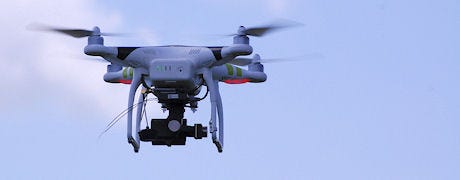
At 10:15 a.m., Chad Colby pulled up to a corn field in central Illinois.
Five minutes later, his pre-flight checks were done and his unmanned aerial vehicle was hovering over the field. Ten minutes after that, Colby was analyzing images in the cab of his truck.
“That’s the beauty of UAV,” notes Colby, who has logged thousands of flight hours with UAV devices. “You pull off on the side of the road and you have images of an entire field in a matter of 10 minutes.”

Flying just above a corn field, a UAV equipped with GoPro camera captures high-definition photos that can help farmers spot signs of insects, disease or weather damage.
UAVs have opened a new world of opportunities for the U.S. farmer. Even though the press tends to focus on stories about Amazon delivering packages or the U.S. Air Force delivering explosives, agriculture will be the biggest industrial application for UAV.
“If this industry can save farmers just 1% on inputs, then it becomes a $1 billion industry over night,” Colby adds.
UAV uses
So, what can these things do? Matt Barnard, founder of Gibson City’s Crop Copters, likes to compare them to backhoes and forklifts.
“You talk to a farmer who’s purchased a backhoe or forklift and they generally say, ‘How did I ever live without this,’” he adds.
Before spending thousands on a UAV, Colby says farmers must identify their mission. A small quad copter model is well-suited for crop scouting. A GoPro camera mounted on a quad copter is perfect for finding insect feeding, disease, hail damage or flooding.
Of course, there are non-traditional uses for the smaller copter models. Barnard notes his company is now receiving requests from Western Illinois growers for a waterproof model so they can inspect pivots from afar. Colby adds that some grain storage personnel are using UAV copters for facility inspections.
However, quad copters have limitations. They do not excel at imaging 200+ acre fields for normalized difference vegetation index. For that sort of work, a wing works best.
Jeff Frank, an Auburn, Iowa farmer and AgEagle dealer, notes a wing is best suited for saving growers money on inputs. One flight on a 30 minute battery can image 480 acres.
Analyzing the data can reveal numerous issues such as drainage, compaction and fertility. “That’s where the payback comes in with this,” Frank adds. “You’re going to be able to better allocate your input dollars so you’re getting the most bang for your buck.”
Future applications
Currently, the U.S. UAV market is in the information stage. This technology is best suited for providing the grower with cost-effective, up-to-the-minute data for making better decisions.
However, Colby expects UAV technology is on the precipice of making a more proactive leap forward. In the near future, he says new UAV models should be able to locate and spot treat problems like Palmer amaranth escapes or an infestation of Japanese beetles.
Sounds futuristic, but Colby notes this sort of spot application has been a reality in Japan since the late 1980s. “We’re actually playing catch up in the U.S.,” he adds.
Yamaha has been using their Rmax, a small gas-powered helicopter, to apply liquid products on more than 2.5 million acres a year.
In the meantime, the UAV industry will continue to explode in popularity. Colby often compares it to the tablet market. In 2010, the first generation iPad hit store shelves. Approximately 300,000 users bought one on the first day. By the end of 2010, approximately 15 million were sold. In October 2013, more than 170 million consumers have purchased iPads.
Those who now own one can’t imagine life before the must-have tablet. Colby expects UAVs will experience the same meteoric rise in popularity.
“The question is what’s stopping you from getting on board now?” he asks.
About the Author(s)
You May Also Like




